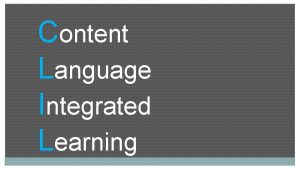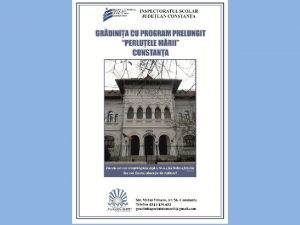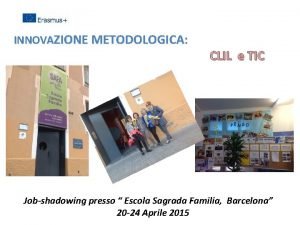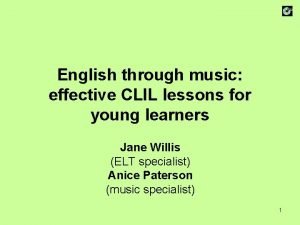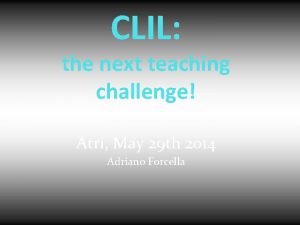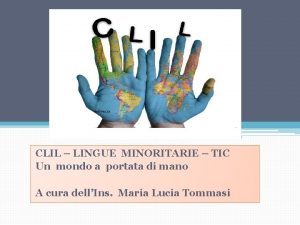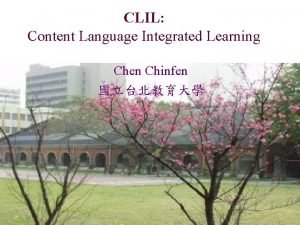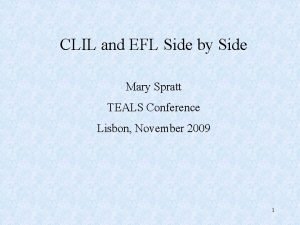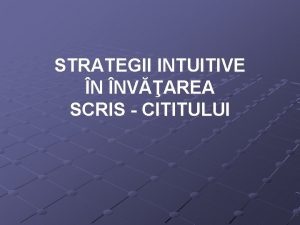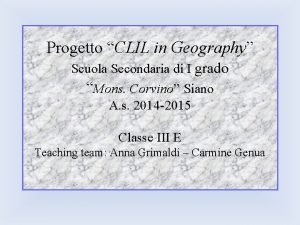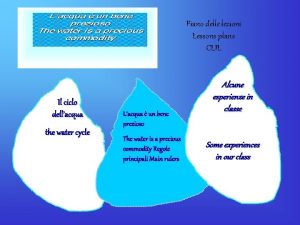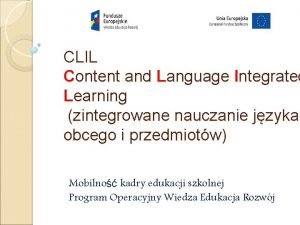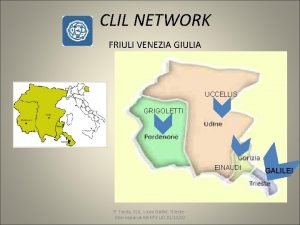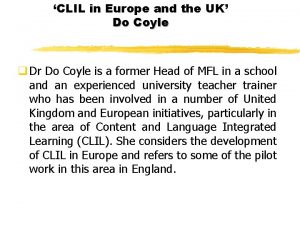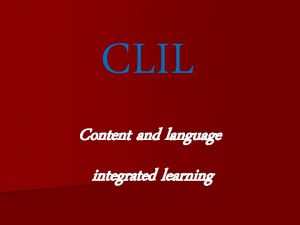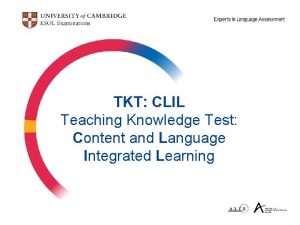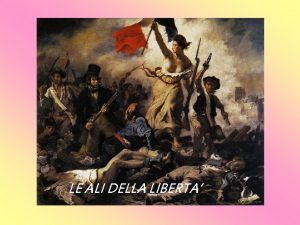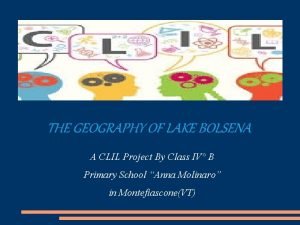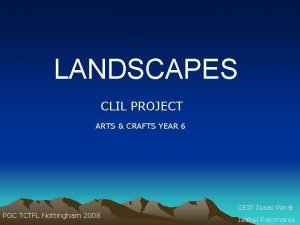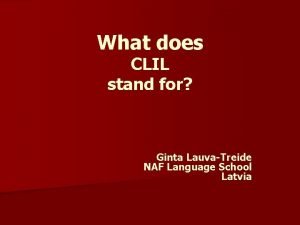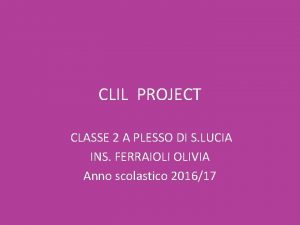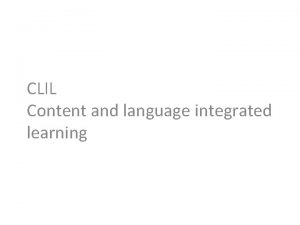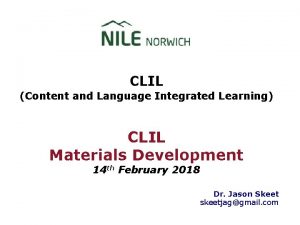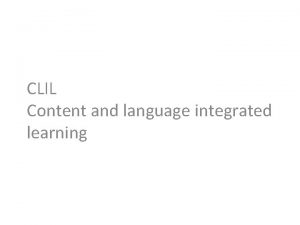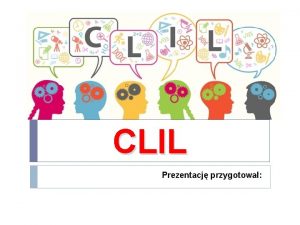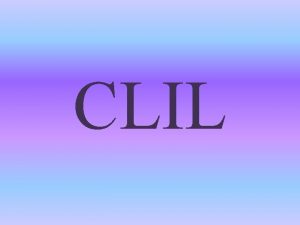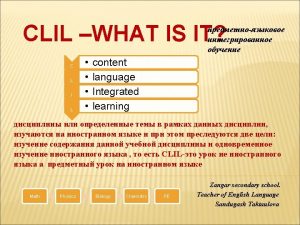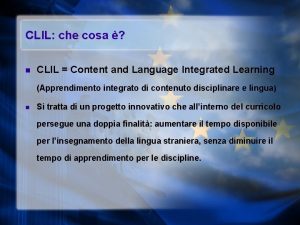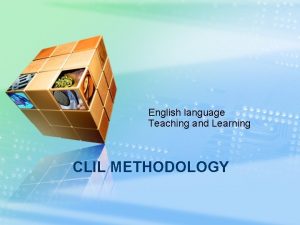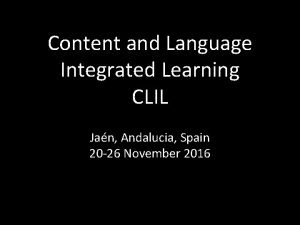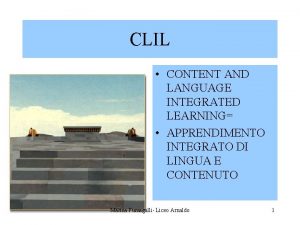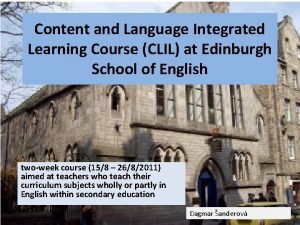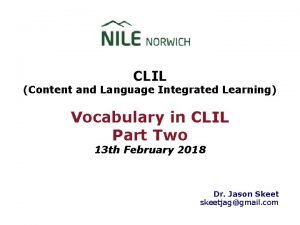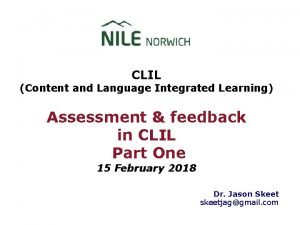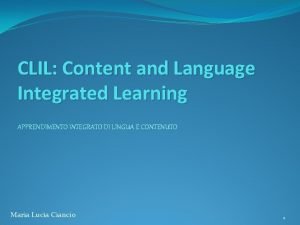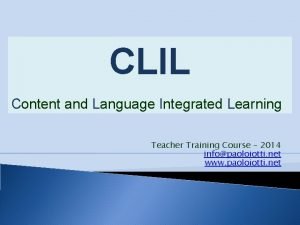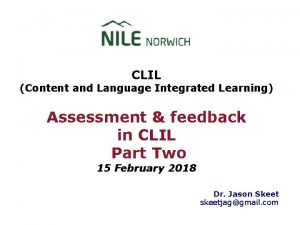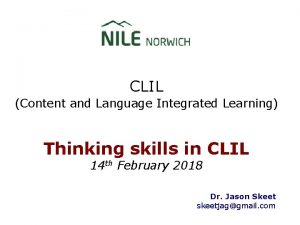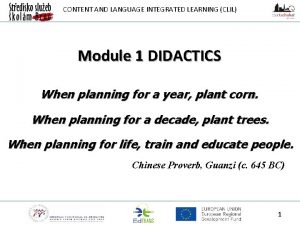Content Language Integrated Learning Definition CLIL is an































- Slides: 31

Content Language Integrated Learning

Definition CLIL is an acronym for Content and Language Integrated Learning. «CLIL is a dual-focused educational approach in which an additional language is used for the learning and teaching of both content and language. That is, in the teaching and learning process, there is a focus not only on content, and not only on language. » Coyle, Hood and Marsh 2010

An overview of methodologies CLIL is a term used to cover a range of context and models. There are schools where some topics of a subject are taught in the selected foreign language (soft CLIL). There are schools where a great part of the syllabus, even an half of it, is taught in the target language (hard CLIL). There also schools where you can teach a certain subject for a range of hours in the target language, a mid-way model between the models listed above. According to Coyle, 2007 and Coyle, Hood and Marsh, 2010 , CLIL has four components known as ‘ 4 Cs’ : CONTENT, COMMUNICATION, COGNITION and

The role of the subject and language teachers CLIL is a teacher- led movement. In some programs, there is cooperation between subject and language teachers, therefore, subject and language teachers have to learn different ways to teach their syllabus to the pupils. Teaching history in CLIL , teachers have to learn different ways to help pupils to interpret events, people and change in the past using an appropriate terminology, because it fuses both content and language learning.

The advantages and disadvantages of the CLIL approach ADVANTAGES: v CLIL can be motivating for both teachers and learners. v CLIL can be of great benefit not only to able learners but to all students across the ability range. v CLIL has a growing potential for providing opportunities involving problemsolving, risk-taking, confidence building , communication skills, extending vocabulary, self-expression and spontaneous talk. v CLIL learners need to discuss, debate, justify and explain using more complex language and different sorts of language than would be practised in the regular foreign language lessons. v CLIL can help pupils to develop global citizenship & intercultural understanding.

DISADVANTAGES: v CLIL isn’t a simple theoretical methodology, CLIL has to be systematically realised with an articulation of effective practices and shared understandings of underlying principles. v CLIL takes place through a progression in knowledge , skills and understandings of content. v CLIL is also bound , as all learning, to the mindset of the pupil. v CLIL environment is higher than a traditional language classroom v Continuous teachers’ prompts (repetition, clarification requests and feedback) force learners to move from semantic to syntactic processing.

The issue of assessment The assess must take into account both subject and language. The acronym CLIL shows that it is an “integrated” learning. In a CLIL class, evaluation is combined with peer evaluation and with self evaluation and will take the form of a dynamic process that constantly evolves. To do so, teachers have to know their pupils’ language level , so they can value the improvement in both curricula and they can decide if it’s more important evaluating, as main object, language or subject.

Lesson Plan Age group: Primary (4° Class) Subject : History Times: 3 lessons (6 hours) Aims: These lessons use History to develop learners’ vocabulary. It includes: • Simple Present • Question Words • Prepositions of place • Comparatives and Superlatives

THE EGYPTIAN CIVILIZATION

WHAT DO THEY DO ? WHERE DO THEY LIVE ? WHAT DO THEY WORSHIP ? Egyptians WHEN ? WHY ARE THEY FAMOUS ? HOW ARE THEY ORGANIZEd ?

WHERE ?

Egypt is in the North. East of Africa. The Egyptians are an ancient popolation. They live along Nile river around 4000 b. C.

Look the map! Egypt is divided in two lands: 1) In the North of the map we can see the delta of Nile in the Mediterranea Sea : LOWER EGYPT. 2) In the South of the map we can

WHEN ?

ANCIENT EGYPT TIMELINE OLD KINGDOM MIDDLE KINGDOM 3100 b. C. Egypt is unifed. 1991 b. C. Egypt expands NEW KINGDOM 332 b. C. Alexander the Great invades Egypt 2650 - 2150 b. C. 30 b. C. Building of the pyramides Roman period

CIVILIZATION TIMELINE Egyptians Mesopotamians (Sumerians, Babilonians e Assyrians) 5000 b. C. 4000 b. C. 3000 b. C. 2000 b. C. 1000 b. C. 0

HOW ARE THEY ORGANIZED?

At the top of the social pyramide there is the Pharaoh. He is the most important person of Egypt and he is considered like a God. He has absolute power. There are many people under him: - Nobles, Priests and Officials - Scribes - Merchants and Artisans - Farmers, Servants and Slaves (they are the least important people of

WHY ARE THEY FAMOUS?

In Egypt writing is very important. It is particular and complicated : there aren’t words but hieroglyphs. What are hieroglyphs? Signs simplified which suggested an object or an action or an idea. There are on temples’ walls, on tombs, on papyrus and contracts.

PYRAMIDES The pyramides are builds between 2650 -2150 b. C. by artisans and engineers. They are Pharaoh’s tombs. This big buildings are realized by stone blocks. The biggest pyramide is Cheope’s pyramide (150 mt). Another very important building is the Sphinx.

WHAT DO THEY WORSHIP?

Egyptians are polytheists: they worship many RA Gods. They dedicate them beautiful temples. Their Gods have a particular aspect. They have the apperance of animals or man or both. The most important are: Ra, Anubis, etc. ANUBIS

Egyptians belive in life after death. For this reason they conserve the body of man with bendages: this practice is called MUMMIFICATION.

ACTIVITY

1) Complete the text The Egyptians are an …………… popolation. Egypt is divided in ……. land. In the North there is ……………… Egypt and in the South there is ……………… Egypt. The egyptian’s history is divided in: ………………… Kingdom, ………… Kingdom and ………………. Kingdom. At the top of the …………………. . pyramide there are the …………………. . There are many people ………… him: - …………………. , Priests and Officials - ………………. . - Merchants and ……………. - ……………. . , Servants and ……………… Egyptians write with …………………. . . Egyptians realize very important buildings: there are called ……………. . . The biggest is

2) Draw the social pyramid on your exercise book 3) Write your name with hieroglyphs on your exercise book

4) Make a papyrus ! … and now write your name on it.

The teacher reads this presentation and with childern’s help creates a vocabulary.

VOCABULARY TO WORSHIP adorare/venerare NILE Nilo LOWER EGYPT Basso Egitto UPPER EGYPT Alto Egitto BUILDING costruzione TO BUILDING costruire ALEXANDER THE GREAT Alessandro Magno MESOPOTAMIANS popoli mesopotamici SUMERIANS Sumeri BABILONIANS Babilonesi ASSYRIANS Assiri PHARAOH faraone GOD Dio NOBLES nobili PRIESTS sacerdoti SCRIBES MERCHANTS ARTISANS FARMER SERVANTS SLAVES HIEROGLYPHS WALL TOMBS PAPYRUS ENGINEERS STONE SPHINX POLYTHEISTS BOTH TO BELIVE DEATH RIDDLE scribi mercanti artigiani contadini servi schiavi geroglifici muri tombe papiro ingegneri pietre Sfinge politeisti entrambi credere morte indovinello

BIBLIOGRAPHY AND SITOGRAPHY: • http: //www. cremit. it/public/documenti/seminar. pdf • http: //riviste. unimi. it/index. php/promoitals/article/view. File/2827/3 030 • http: //www. slideshare. net/mirun/clil-5 -assessment-in-clil • (libro simona) • (libro sussidiario) • Slides • Google pictures
 Clil meaning
Clil meaning Real content and carrier content in esp
Real content and carrier content in esp Dynamic content vs static content
Dynamic content vs static content Esempio di lezione clil diritto
Esempio di lezione clil diritto Care sunt cele patru componente ale metodei clil
Care sunt cele patru componente ale metodei clil Tic e clil
Tic e clil Clil music lesson plan
Clil music lesson plan Clil matrix
Clil matrix Clil meaning
Clil meaning Clil e tic
Clil e tic Advocators education
Advocators education Language
Language Clil meaning
Clil meaning Clil metodi
Clil metodi Metoda globala de invatare a cititului
Metoda globala de invatare a cititului Clil geografia scuola media
Clil geografia scuola media Clil ciclo dell'acqua
Clil ciclo dell'acqua Language
Language Clil grigoletti
Clil grigoletti Do coyle
Do coyle Clil showers
Clil showers Tkt clil
Tkt clil Progetto clil
Progetto clil Metodologia clil
Metodologia clil Hard clil
Hard clil The solar system clil
The solar system clil Clil geography primary school
Clil geography primary school Tctfl
Tctfl Tarkoma
Tarkoma Clil water
Clil water Clil
Clil Clil topics
Clil topics
